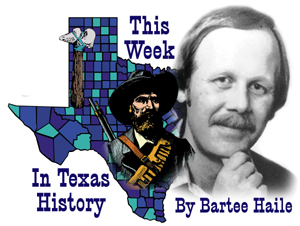 To the delight of children of all ages, Mollie Bailey brought her circus, a Texas institution for four fun-filled decades, to Conroe on Feb. 10, 1913. When Mollie Arline Kirkland sneaked a forbidden peek under the big top in 1858, it was love at first sight on two counts. The lure of the sawdust spectacle was surpassed only by her instant attraction to the redheaded leader of the circus band.
To the delight of children of all ages, Mollie Bailey brought her circus, a Texas institution for four fun-filled decades, to Conroe on Feb. 10, 1913. When Mollie Arline Kirkland sneaked a forbidden peek under the big top in 1858, it was love at first sight on two counts. The lure of the sawdust spectacle was surpassed only by her instant attraction to the redheaded leader of the circus band.
 To the delight of children of all ages, Mollie Bailey brought her circus, a Texas institution for four fun-filled decades, to Conroe on Feb. 10, 1913.
To the delight of children of all ages, Mollie Bailey brought her circus, a Texas institution for four fun-filled decades, to Conroe on Feb. 10, 1913.
When Mollie Arline Kirkland sneaked a forbidden peek under the big top in 1858, it was love at first sight on two counts. The lure of the sawdust spectacle was surpassed only by her instant attraction to the redheaded leader of the circus band.
Mollie’s bombshell announcement of her wedding plans polarized her parents. Her mother, an incurable romantic, secretly gave her blessing, but her father banned Gus Bailey from the family plantation. A gypsy musician was not the husband he had in mind for his debutante daughter, and besides she was barely 13 years old.
After the teenager eloped over his objections, the head of the household closed his door and his heart to his favorite child. Mollie’s attempts at reconciliation were scornfully rebuffed by a father, who refused to have anything to do with her for the rest of his life.
Recruiting Mollie’s half sister and Gus’ brother for a vaudeville act billed as the “Bailey Family Troupe,” the couple toured the South until the outbreak of war in 1861. While Gus fought with Hood’s Texas Brigade, Mollie entertained the troops and occasionally spied for the Confederate cause. Dressed as an elderly woman, she ventured behind Union lines to gather important intelligence.
The Baileys scraped through the lean years of Reconstruction with a stripped-down version of their prewar road show. But thanks to Mollie’s scrimping and saving they had accumulated the cash by 1880 to realize two inseparable dreams – a return to Texas and a circus of their own.
“A Texas Show for Texas People” followed the trail blazed by pioneer predecessors like John Robinson’s “Great Southern Show,” which thrilled citizens of the recently annexed Republic in 1850. “Mabie’s Circus and Menagerie” amazed audiences eight years later with a trio of elephants, including an enormous bull that nearly plunged to his death after breaking through a bridge outside Waco.
Gus Bailey’s death in 1896 put his resourceful widow in a class by herself. Mollie became the only woman before or since to have exclusive ownership and control of a circus.
Her six surviving children composed the early nucleus of entertainers. Eugene put the trained ponies through their paces, and Allie did the same with the dogs when not demonstrating his acrobatic ability. Brad was an accomplished tumbler and high-wire artist, while Willie shared the business headaches with his overworked mother. Minnie and Birdie, the two girls, were gifted singers and dancers.
After a quarter century of battling bad roads and axle-deep mud, Mollie traded her wagons for a Pullman and two freight cars in 1906. Her custom of holding an open house in her home on rails at each and every stop inspired a piece of popular slang. “Just Mollie Baileying around” referred to anyone constantly on the go and having a good time wherever he or she went.
Countless Texans saw their first motion picture in a tent theater in the circus side show. Always in the market for novel attractions to boost attendance, Mollie took primitive one-reelers to small communities that lacked the population to support the nickelodeons that were all the rage in the big cities.
So long as she covered expenses, paid her employees and had enough money left over to meet her simple personal needs, “The Circus Queen of the Southwest” was happy. Acutely aware of the impoverished plight of her rural customers, Mollie refused for nearly 40 years to increase the price of admission. She also made sure that orphans and Confederate veterans, and after the turn of the century their Yankee counterparts as well, got in free.
Instead of the carefree existence imagined by the casual observer, circus life was in reality a grueling grind. The Bailey performers played a different town seven days a week for ten months a year. December and January were reserved for rest, repairs and auditioning aspiring acts at the home base in Dallas during the 1880’s, Blum in the early 1890’s and Houston after 1896.
Although Mollie stayed behind in 1914 to nurse her bedridden daughter Birdie, she did not relinquish the reins to her four sons. The astute businesswoman issued detailed instructions dealing with every aspect of the daily operation in a steady stream of letters, telegrams and telephone calls.
But after Birdie passed away in the fall of 1917, Mollie was never the same. She lost interest in her beloved circus and maybe even in life. Hobbled by a fractured hip, her health steadily declined until her death in October 1918 at age 73.
Her own words would have made a fitting epitaph. “Do some good as you go along and leave a good name with the people you have met,” Mollie Bailey was fond of saying. “I don’t want the earth, and some day I shall get only a small space in it.”
Bartee Haile welcomes your comments, questions and suggestions at haile@pdq.net or P.O. Box 152, Friendswood, TX 77549. And come on by www.twith.com for a visit!